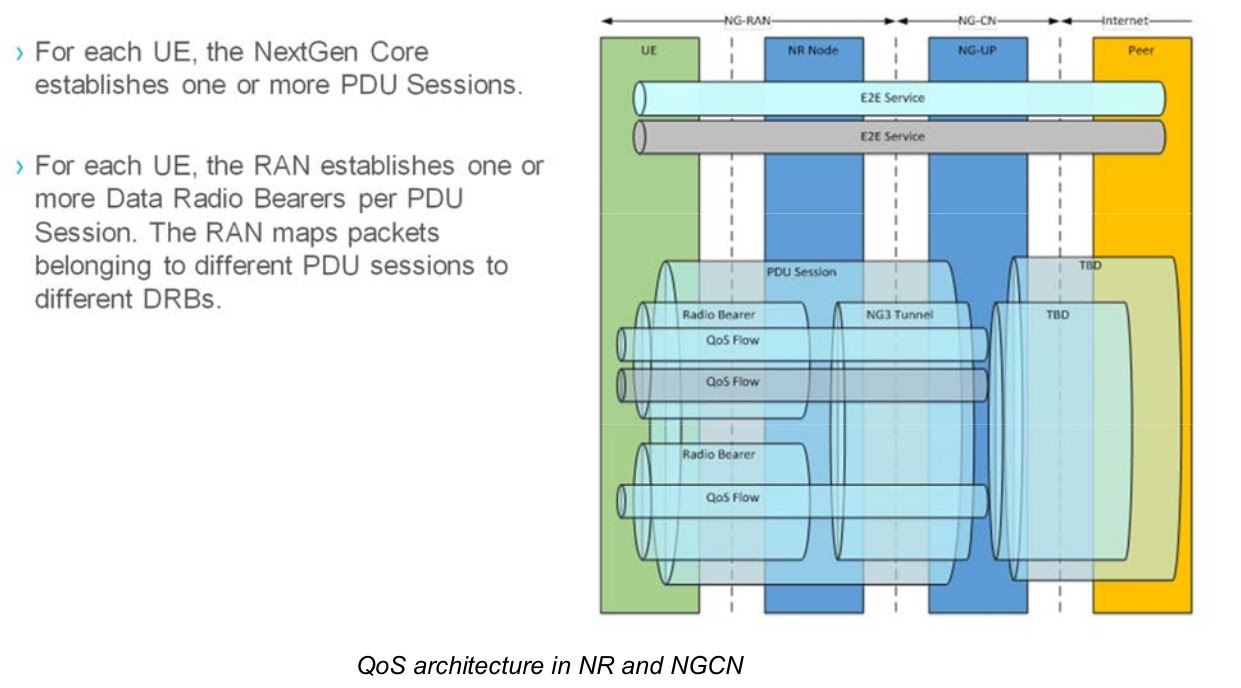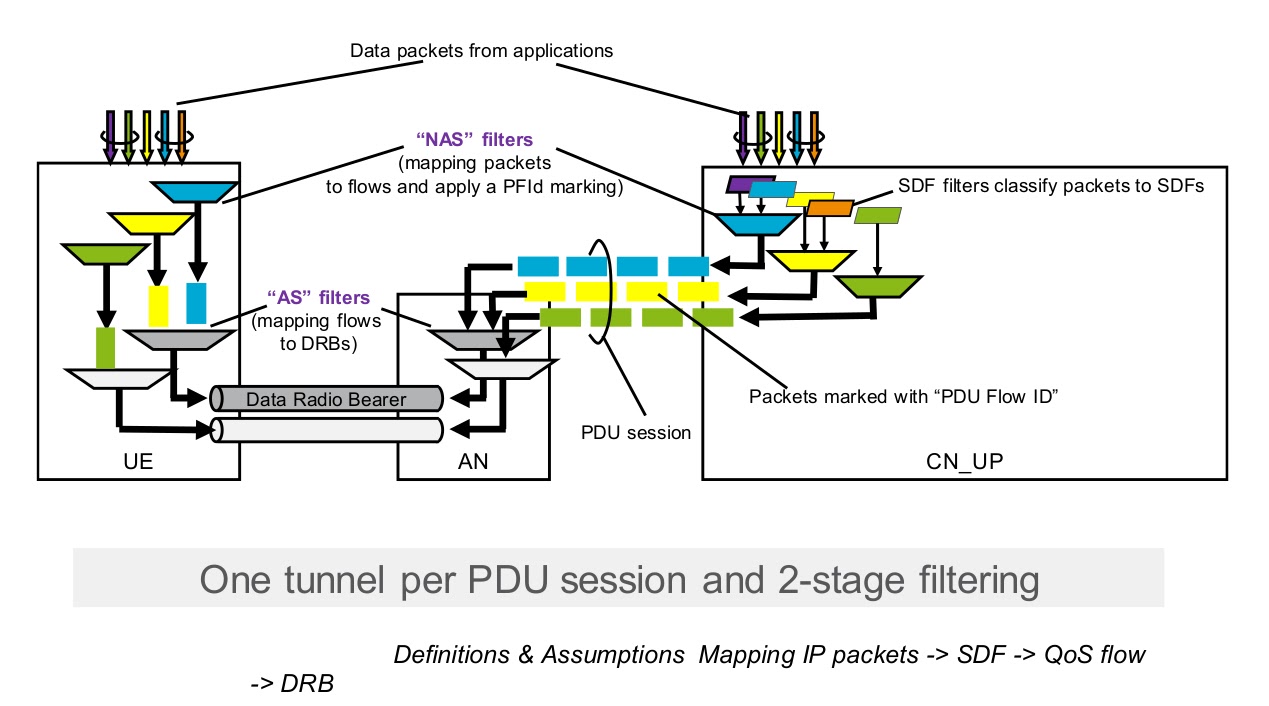Quality of Service (QoS) with 5GC Quality
A flow in this context is a QoS flow: all Packet Data Units (PDUs) that will receive the same QoS facility in the network, are used to classify PDUs into QoS flows. Filters can be provided with 5G policy control or can be pre-configured in 5G cores.QoS Model General Overview
The 5G QoS model supports the QoS flow-based framework. The 5G QoS model supports both QoS flows that require guaranteed flow bit rates and QoS flows that do not require guaranteed flow bit rates. The 5G QoS model also supports reflective QoS.QoS flow is the best granularity of QoS resolution in a PDU session.
QoS flow is the best granularity of QoS resolution in a PDU session. QoS Flow ID (QFI) is used to identify QoS flows in a 5G system. User plane traffic with the same QFI within the PDU session receives the same traffic forwarding treatment (eg scheduling, admission threshold). The QFI is carried in an encapsulation header on N3 (and N9), ie without making any changes to the e2e packet header. It can be applied to various types of payloads, ie IP packets, non-IP PDUs, and PDUs with Ethernet frames. The QFI will be unique within the PDU session.
QoS flow is the best granularity of QoS resolution in a PDU session. QoS Flow ID (QFI) is used to identify QoS flows in a 5G system. User plane traffic with the same QFI within the PDU session receives the same traffic forwarding treatment (eg scheduling, admission threshold). The QFI is carried in an encapsulation header on N3 (and N9), ie without making any changes to the e2e packet header. It can be applied to various types of payloads, ie IP packets, non-IP PDUs, and PDUs with Ethernet frames. The QFI will be unique within the PDU session.
Note: Policing of user plane traffic (eg MFBR enforcement) is not considered QoS differentiation and is carried out by the UPF at SDF level granularity.
Each QoS flow (GBR and non-GBR) is associated with the following QoS parameters:
- 5G QoS Indicator (5QI),
- Allocation and Retention Priority (ARP).
- Guaranteed Flow Bit Rate (GFBR) - UL and DL;
- Maximum flow bit rate (MFBR) - UL and DL;
- Notification control.
1) For non-GBR QoS flows with standardized 5QI, the standardized 5QI value is used as QFI and the default ARP is used. In this case no additional N2 signaling is required at the time of traffic when the corresponding QoS flow starts, or;
2) For GBR and non-GBR QoS flows, all the required QoS parameters related to QFI are sent as a QoS profile to the (R) AN in the PDU session establishment or QoS flow establishment / modification
The QoS parameters of a QoS flow are provided to the (R)AN as a QoS profile over N2 at PDU Session or at QoS flow establishment and when 5G-RAN is used at every time the User Plane is activated. QoS parameters can be pre-configured in (R) AN for non-GBR QoS flows (ie without the need to signal over N2).
The UE classifies and marks the UL user plane traffic based on QoS rules, that is, the linking of uplink traffic to the QoS flow. These rules can be explicitly signalled over N1 (on PDU session establishment or QoS flow establishment), preconfigured in UE or implicitly derived by UE from reflective QoS. The QoS rule consists of a QoS rule identifier, the QFI of the QoS flow, and a QoS flow template (ie the set of packet filters and the associated precedence values associated with the QoS flow).
A default QoS rule is required for every PDU session. The default QoS rule shall be the only QoS rule of a PDU session which is allowed not to have a QoS flow template. If the default QoS rule does not contain a QoS flow template, the default QoS rule defines the treatment of packets that do not match a QoS flow template of a QoS rule in a PDU session.
The SMF allocates the QFI for each QoS flow and derives its QoS parameters from the information provided by the PCF. When applicable, the SMF provides the QFI with a QoS profile containing the QoS parameters of a QoS flow to the (R)AN. The SMF provides the SDF template (i.e. the set of packet filters associated with the SDF derived from the PCF) with the SDF preference and the corresponding QFI to the UPF enabling the classification and marking of user plane traffic. When applicable, SMF generates QoS rule (s) for QoS flows by allocating QoS rule identifiers, adding QFIs to QoS flows, and setting the QoS flow template using one or more SDF templates. QoS rules are then provided to the UE to enable classification and marking of UL user plane traffic.
For DL traffic AN can detect which flow a received packet belongs to by looking in the encapsulation tunnel header, where the UPF has marked the packet with the QoS Flow Indicator (QFI). Information about the treatment of each flow is sent from 5GCN to AN over N2.
UE for UL traffic marks traffic with the correct QFI based on the information received from the SMF over N1 interface. The solution will also be available for Reflective QoS where the UE marks the UL traffic based on which QFI is the DL traffic corresponding to the same flow. AN informs the UE how to send PDUs over the air (which radio bearer to use).
Each PDU session in a session establishment is associated with a default QoS profile (a set of QoS parameters).
- The default QoS profile is usually configured in UDM and can be authorized by PCF
- The QoS profile indicates the treatment of all PDUs transferred within the PDU session and for which the network has not indicated PDU specific treatment.
- The PCF can modify the default QoS profile for a PDU session at any time during the session
QoS parameters per QoS flow:
- 5G QoS indicator (5QI)
- Allocation and Retention Priority (ARP)
- Maximum Flow Bit Rate
- Guaranteed Flow Bit Rate
- Notification control. Controls whether notification should be made if the QoS targets are no longer fulfilled for a QoS flow
QoS parameters per PDU session
- Aggregated session maximum bitrate (UL and DL) for all QoS flows of a PDU session that do not require a guaranteed flow bit rate.
- Aggregated UE maximum bitrate (UL and DL) for all QoS flows and sessions of the UE that do not require a guaranteed flow bit rate.
- Multiplexing flow within a PDU (PDN) session tunnel
- Flow identities indicates on the QoS profile
- The DRB is mapped to the PDU session tunnel
- Multiple DRBs possible per PDU session tunnel
- The PDCP header on UL carries the Flow Id to map to DSCP on UL
- Each packet have the DL Flow ID
Services are mapped to the Service Data Flow (SDF)
SDF, which consists of the following, assigned QoS profile:- SDF priority
- Maximum bitrate per SDF:
- Bitrate required per SDF
- Delivery characteristic per SDF
- Network behavior per service data flow
QoS flow, which contains the following parameters, a QoS profile is assigned:
- QoS flow priority
- Maximum bitrate per QoS flow
- Bitrate required per QoS flow
- Delivery characteristic per QoS flow
- Network behavior per QoS flow
The SDF of the same IP-CAN session can be considered as the SDF Aggregate
- All SDFs should have the same QCI / ARP
- GBR / MBR is summarized in GBF SDFs when multiplexing GBR SDFs
SDF Aggregates are mapped to UL/DL Packet Filters/EPS Bearers
- 1:1 relation – an SDF Aggregate uniquely defines the EPS Bearer
- Bearer QoS profile (QCI, ARP, GBR, MBR), per-UE parameter AMBR and subscription parameter RFSP signaled over S1
QoS Flow Id is mapped to Radio Bearers
- N: 1 relation
Based on pre-configured nodes, via OSS-RC
- Standardized QCI Characteristics
- Resource Type
- GBR / Non-GBR
- Packet Delay Budget (PDB)
- Packet Loss Rate (PLR)
- Priority
- Priority between bearers when target PDB cannot be met (by bearers
- competing for the same resource)
- Other parameters set in OSS, by operator in MOM











0 comments:
Post a Comment
Dear reader if you have any question that's you want to know answer please write it to in comment box i will post answer ASAP..!!